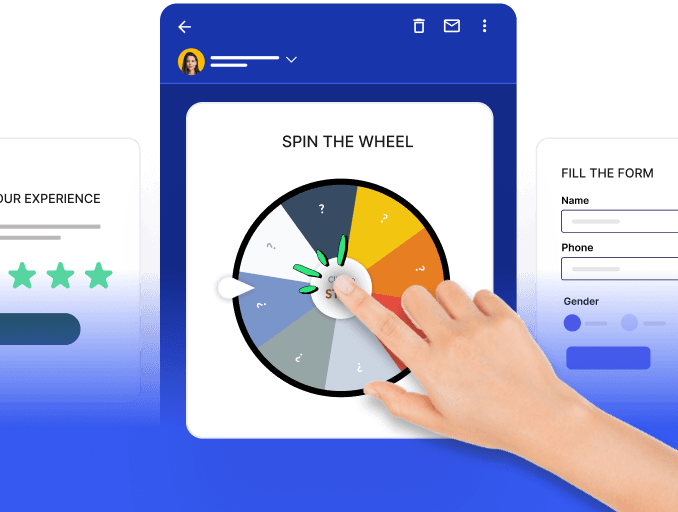For online merchants, a higher conversion rate is the mark of success in a world filled with digital storefronts beckoning with various offerings. Shopify stores have the potential to turn curious visitors into delighted customers with every click, hover, and interaction.
The following guide explores the basics of conversion rate optimization for your Shopify store, and discusses the 10 best strategies that you can implement to increase the conversion rate of your Shopify store.
Table of Contents
10 CRO strategies to increase your conversion rate
- 1. Optimize your store to offer the best user experience
- 2. Improve site navigation by analyzing customer behavior
- 3. Improve user experience by ensuring your web page loads quickly
- 4. Confirm your Shopify shop is mobile-responsive
- 5. Utilize insights from heat maps for in-depth analysis
- 6. Optimize your most important conversion paths
- 7. Use popups
- 8. Run A/B tests
- 9. Create smart search bars
- 10. Set up email automations
What is conversion rate optimization for a Shopify store?
Conversion Rate Optimization (CRO) for a Shopify store involves systematically enhancing the website's elements and user experience to increase the percentage of website visitors who complete a desired action. The primary goal is converting visitors into customers, subscribers, or leads.
You can effectively optimize your conversion rate by improving the user experience and focusing on the specific aspects of your product or service. The primary objective is to find out what works best for you and your existing customers and then use this knowledge to improve the store.
Where to start with CRO for your Shopify store?
Here are three key areas of your website where you can implement CRO to improve user experience and boost conversions:
Ecommerce websites rely heavily on product pages and can greatly benefit from CRO. So, by optimizing your product images, descriptions, or brand voice, you can see the change for yourself.
Your blog posts, particularly those optimized for search engines, draw readers and present an additional avenue to boost conversions. Emphasise on call to action and lead generation within your posts to capitalize further on this opportunity.
Landing pages are designed to convert visitors to leads or customers. By refining the information hierarchy through iterative testing, you can have a great first impression, which ultimately converts.
10 CRO strategies to increase your conversion rate
All ecommerce stores strive to increase sales, but only some understand what needs to be changed. To increase sales, you need to understand what drives, stops, and persuades your users so you can give them the best UX possible. The following strategies will help you navigate one component at a time.
1. Optimize your store to offer the best user experience
User experience is all about creating a positive experience for your visitors. Concentrating on UX design enables websites to provide a captivating, intuitive, and user-friendly experience. This results in heightened user engagement and fewer visitors leaving the site abruptly, consequently positively influencing conversion rates.
A successful website hinges on an effective user experience (UX) design, blending several vital components. These critical elements contribute to a robust UX design:
Navigation: Ensuring a website is easily navigable with an intuitive structure enables swift and effortless information retrieval for users.
Content: Clear, concise, and well-organized content, complemented by proper headings and subheadings, aids users in comprehending presented information.
Accessibility: Prioritizing accessibility for all users, including those with disabilities, involves screen reader compatibility, alt text for images, and legible font choices.
Responsiveness: Adapting to various screen sizes and devices guarantees a consistent user experience across desktops, tablets, and mobile devices.
Usability: Simplifying interactions facilitates swift task completion, fostering a user-friendly environment.
Aesthetics: Visual design impacts user perception. Employing suitable colors, typography, and imagery creates an appealing and engaging user experience.
2. Improve site navigation by analyzing customer behavior
Analyzing customer behavior on your website provides invaluable insights into optimizing site navigation. By understanding how users interact with your site, you can identify pain points, preferred pathways, and areas needing improvement in navigation design.
Implementing tools for tracking user behavior and feedback frameworks aids in comprehending user actions, preferences, and navigation patterns, enabling informed enhancements. This iterative process aligns site navigation with user expectations, enhancing the user experience.
For instance, you're running an online store specializing in outdoor gear. Your navigation bar could include hiking, camping, climbing, and cycling categories. You can incorporate dropdown menus within each primary category to offer more detailed selections. For example:
Hiking: The dropdown could include hiking boots, backpacks, trekking poles, and hydration packs.
Camping: Subcategories might feature tents, sleeping bags, camping stoves, and portable chairs.
Climbing: This category could unveil climbing shoes, ropes, harnesses, and carabiners.
Cycling: Dropdown options could showcase road bikes, mountain bikes, cycling apparel, and bike accessories.
By organizing your products this way, customers can efficiently explore your store, quickly finding the specific gear they need for their outdoor adventures.
3. Improve user experience by ensuring your web page loads quickly
The speed at which your site loads significantly influences user retention and conversions. While numerous Shopify apps aim to enhance conversion rates, some inadvertently slow down your store's performance.
To improve load speed, you can:
Uninstall unused plugins.
Compress all images and deactivate non-utilized features in your Shopify theme.
Use third-party tools to create a site with custom breakpoints for ultra-responsive and dynamic site design.
Leveraging third-party tools like Hotjar and Pendo helps comprehend user behavior, pinpointing underused features. This insight lets you turn off such features, minimizing their impact on load speed.
4. Confirm your Shopify shop is mobile-responsive
If your conversion rate optimization (CRO) efforts solely target desktop users, you overlook a significant portion of your audience. Mobile wallets account for roughly half of global ecommerce payment transactions. Ensure mobile responsiveness by using Google's mobile-friendly test tool with your site's URL.
Ensuring your Shopify store is mobile responsive is crucial for providing a seamless user experience across devices. Here’s what you can do to make your Shopify store mobile responsive:
Choose a responsive Shopify theme or customize your existing one to adapt seamlessly to various screen sizes and devices.
Utilize Google's Mobile-Friendly Test tool - Google lighthouse, to verify if your website meets mobile responsiveness standards.
Ensure images, text, and buttons are appropriately sized for mobile devices to ensure fast load times.
Consider compressing images using using third-party tools like Imageoptim .This strips away unnecessary data without affecting image resolution.
Simplify navigation menus and buttons for easy access on smaller screens, enhancing user experience.
Since page speed is used by Google when it sorts sites, it is important to provide a better user experience, which improves search engine rankings.
5. Utilize insights from heat maps for in-depth analysis
Heatmaps are invaluable tools for visually displaying user interactions highlighting hotspots of activity, clicks, and scrolls on webpages. This helps understand user behavior, common user patterns, preferences, and areas of interest on web pages. This guides optimization efforts to enhance those specific elements or sections. This assists in optimizing webpage layouts, CTA placement, and content arrangement based on user engagement and interaction data.
The following types of heatmaps will help interpret data:
Click maps help detect where users click when browsing your ecommerce website.
Scroll maps help indicate where users have scrolled and utilize that data to see the web page length.
Eye-tracking heatmaps help indicate the attention each section or element captures on the website.
Based on these findings, you can optimize your store with:
Better button placements
Improve your Call to action
Write a better sales copy
Enhance your UX design
💡 Related guide:
6. Optimize your most important conversion paths
The conversion funnel in a Shopify store commonly follows this sequence:
Product page > Shopping cart > Checkout page > Thank you page.
Examining micro-conversions between these stages is essential to identify drop-off points where users disengage instead of progressing.
This graph compares the number of views vs the number of times each product was added to a shopping cart of an artisanal coffee Shopify store. This helps the store owner identify which blends are most viewed and which make it to customer carts.
Further, this helps adjust the marketing strategy, focusing on promotional efforts of popular products, which helps drive sales while experimenting with different marketing techniques for products with high views but low add-to-cart rates.
Also, with GA4, you can gather insights into the sequence of user interactions with your marketing channels that leads to a conversion that is similar to the customer journey of the Shopify store. The conversion path offered by GA4 takes you through various touchpoints with your marketing channels before completing a conversion.
7. Use popups
A popup is a small window or notification that appears on a webpage after it loads. These are frequently used to draw attention to important information relevant to most visitors, such as an available discount code, or to inform them about ongoing events, like recent purchases made on the site.
The purpose of popups is to capture the user's attention, potentially increasing the website's conversion rate. They can trigger based on specific user actions, such as when visitors display exit intent by moving their cursor toward the top of the screen.
Further, popups serve as an opportunity to gather leads by offering valuable content or discounts in exchange for a visitor's contact information.
8. Run A/B tests
A/B testing, also called split testing, constitutes a form of conversion rate experimentation. It involves comparing two versions of the same web page or content to determine the more effective one.
The objective of A/B testing is to validate a variant of your content, such as its layout or call to action. Both versions are simultaneously presented to similar visitor groups. The variant with a higher average conversion rate is deemed the winner and implemented for the entire audience.
This versatile testing method applies to various conversions, not limited to sales. It requires a hypothesis for content improvement, at least one variant, and a test audience segment.
Subjects for A/B testing encompass elements like buttons, banners, backgrounds, and email subject lines. Variants can be entirely new content or subtle adjustments, like changing font colors or enhancing page contrast.
However, ensuring adequate website traffic before conducting A/B tests to yield statistically significant results is important.
9. Create smart search bars
When visitors arrive at your website through a social media ad or search engine query, they might not have a specific product in mind. This is where your navigation bar becomes a crucial tool in turning casual browsers into potential leads.
Especially if your store boasts a wide array of products, highlighting the search bar prominently on your homepage can streamline user experience. By offering users the chance to swiftly navigate to their desired destination instead of sifting through various categories, you enhance their satisfaction.
Third party tools like Searchanise elevate user experience by incorporating predictive results functionality. This aids customers in finding what they seek more rapidly. As users type, the intelligent search function anticipates and suggests possible spelling errors and alternative product names.
10. Set up email automations
Re-engaging dormant cart owners by implementing email automations is a well-established conversion rate optimization (CRO) strategy.
Automated abandoned cart emails take advantage of the association between abandoned carts and customer email addresses. Craft emails that remind customers of their abandoned items while offering incentives like discounts or free shipping codes to motivate them to finalize their purchase. Email design is an important aspect to focus on as it influences your email campaigns' effectiveness and overall impact.







